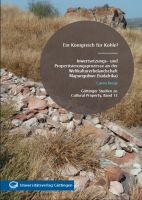Ein Königreich für Kohle?
Inwertsetzungs- und Propertisierungsprozesse an der Weltkulturerbelandschaft Mapungubwe (Südafrika)
| dc.contributor.author | Bergs, Caren | |
| dc.date.accessioned | 2020-04-15T02:45:02Z | |
| dc.date.available | 2020-04-15T02:45:02Z | |
| dc.date.issued | 2017 | |
| dc.identifier | OCN: 1038423875 | |
| dc.identifier.uri | http://library.oapen.org/handle/20.500.12657/37160 | |
| dc.description.abstract | The South African UNESCO world heritage site of Mapungubwe Cultural Landscape became the site of a conflict in 2011, when a coal mine was built in close proximity. The area of tension evolved around matters of conservation of culture, socio-economic development, environmental and nature protection, as well as the generation of identity. Following the conflict and its actors, the author shows the valorisation/valuation of Mapungubwe's resources as well as processes of propertisation against the backdrop of the special obstacles after the end of apartheid. Utilising interdisciplinary research approaches and an understanding of resource as a relational assemblage, the author follows the shifting of discourses between conservation of culture and extraction of resources from the local to the international level. She shows that power of interpretation is bound to time, place and actors when it comes to constituting cultural property. | |
| dc.language | German | |
| dc.subject.classification | thema EDItEUR::J Society and Social Sciences | en_US |
| dc.title | Ein Königreich für Kohle? | |
| dc.title.alternative | Inwertsetzungs- und Propertisierungsprozesse an der Weltkulturerbelandschaft Mapungubwe (Südafrika) | |
| dc.type | book | |
| dc.type | book | |
| oapen.identifier.doi | 10.17875/gup2017-1037 | |
| oapen.relation.isPublishedBy | ffaff15c-73ed-45cd-8be1-56a881b51f62 | |
| oapen.collection | AG Universitätsverlage | |
| oapen.description.otherlanguage | Das südafrikanische Mapungubwe Cultural Landscape, seit 2008 UNESCO-Weltkulturerbe, wurde 2011 bis 2014 zu einem Konfliktschauplatz. Durch die Errichtung eines Kohletagebaus in nächster Nähe eröffnete sich ein Spannungsfeld zwischen Kulturerbebewahrung, sozio-ökonomischer Entwicklung, Umwelt- und Naturschutz sowie der Schaffung von Identität. Den Konflikten und ihren Akteur*innen folgend, arbeitet die Autorin die Inwertsetzung der in und um Mapungubwe vorhandenen Ressourcen sowie die Propertisierungsprozesse vor dem Hintergrund der besonderen Herausforderungen nach dem Ende der Apartheid heraus. Dabei versteht sie Ressource als relationale Assemblage. Unter Zuhilfenahme interdisziplinärer Forschungsansätze verfolgt die Autorin den Wechsel der Diskurse zwischen Kulturerbebewahrung und Bodenschatzförderung bis auf die internationale Ebene und zeigt die Zeit-, Orts- und Akteursgebundenheit von Deutungsmacht bei der Konstituierung von kulturellem Erbe auf. |

